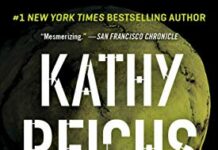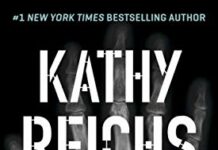
Ebook Info
- Published: 2006
- Number of pages: 352 pages
- Format: MOBI
- File Size: 0.56 MB
- Authors: Kathy Reichs
Description
From bestselling author Kathy Reichs comes a book set in Charleston, South Carolina, the center of a lucrative, clandestine, sophisticated trade in body parts—the kind that leaves the donor dead.
Summoned to South Carolina to fill in for a negligent colleague, Tempe is stuck teaching a lackluster archaeology field school in the ruins of a Native American burial ground on the Charleston shore. But when Tempe stumbles upon a fresh skeleton among the ancient bones, her old friend Emma Rousseau, the local coroner, persuades her to stay on and help with the investigation. When Emma reveals a disturbing secret, it becomes more important than ever for Tempe to help her friend close the case.
The body count begins to climb. An unidentified man is found hanging from a tree deep in the woods. Another corpse shows up in a barrel. There are mysterious nicks on bones in several bodies, and signs of strangulation. Tempe follows the trail to a free street clinic with a belligerent staff, a suspicious doctor, and a donor who is a charismatic televangelist. Clues abound in the most unlikely places as Tempe uses her unique knowledge and skills to build her case, even as the local sheriff remains dubious and her own life is threatened.
Tempe’s love life is also complicated. Ryan, her current flame, has come down to visit her from Montreal, and Pete, her former husband, is investigating the disappearance of a local woman—and he and Tempe are staying in the same borrowed beach house. Ryan and Pete compete for her attentions, and Tempe finds herself more distracted by her feelings for both men than she expected.
Break No Bones is a smart, taut thriller featuring the kind of high-stakes crime that makes the headlines every week. Reichs, the inspiration for the hit Fox TV show Bones, is writing at the top of her form, and Tempe has never been more compelling.
User’s Reviews
“A rare treat….Mesmerizing.” – Ann Rule “Engrossing.” – Entertainment Weekly “Tempe Brennan is the lab lady most likely to dethrone Patricia Cornwell’s Kay Scarpetta.” — USA Today “A brilliant novel….Fascinating science…A must-read.” – Jeffery Deaver About the Author Kathy Reichs’s first novel Déjà Dead, published in 1997, won the Ellis Award for Best First Novel and was an international bestseller. Cold, Cold Bones is Kathy’s twenty-first entry in her series featuring forensic anthropologist Temperance Brennan. Kathy was also a producer of Fox Television’s longest running scripted drama, Bones, which is based on her work and her novels. One of very few forensic anthropologists certified by the American Board of Forensic Anthropology, Kathy divides her time between Charlotte, North Carolina, and Montreal, Québec. Visit her at KathyReichs.com or follow her on Twitter @KathyReichs. From Publishers Weekly The success of the Fox TV show Bones, based on bestseller Reichs’s series featuring forensic anthropologist Temperance Brennan (Cross Bones, etc.), bodes well for this latest installment, in which Brennan once again stumbles on a modern-day mystery inadvertently. While supervising a dig of Native American burial grounds in Charleston, S.C., Brennan finds more recent remains. Soon, her ex-husband, who’s a lawyer, appears in town, pursuing leads in a missing persons case connected with a local church. Bodies start piling up at an alarming rate, and Brennan begins to suspect that the deaths are linked to each other—and her ex-husband’s inquiry. Reichs’s down-to-earth heroine is an appealing creation, who deftly juggles personal problems with professional challenges. Despite the somewhat obvious solution, this novel confirms the series’ place in the front rank of the ever-expanding forensic thriller subgenre. (July) Copyright © Reed Business Information, a division of Reed Elsevier Inc. All rights reserved. –This text refers to an alternate kindle_edition edition. From the Author Kathy Reichs, like her character Temperance Brennan, is a forensic anthropologist, formerly for the Office of the Chief Medical Examiner in North Carolina and currently for the Laboratoire de sciences judiciaires et de médecine légale for the province of Quebec. A professor in the department of anthropology at the University of North Carolina at Charlotte, she is one of only seventy-nine forensic anthropologists ever certified by the American Board of Forensic Anthropology, is past Vice President of the American Academy of Forensic Sciences, and serves on the National Police Services Advisory Board in Canada. Reichs’s first book, Déja Dead, catapulted her to fame when it became a New York Times bestseller and won the 1997 Ellis Award for Best First Novel. –This text refers to an alternate kindle_edition edition. Excerpt. © Reprinted by permission. All rights reserved. Break No Bones 1 NEVER FAILS. YOU’RE WRAPPING UP THE operation when someone blunders onto the season’s big score. OK. I’m exaggerating. But it’s damn close to what happened. And the final outcome was far more disturbing than any last-minute discovery of a potsherd or hearth. It was May 18, the second-to-the-last day of the archaeological field school. I had twenty students digging a site on Dewees, a barrier island north of Charleston, South Carolina. I also had a journalist. With the IQ of plankton. “Sixteen bodies?” Plankton pulled a spiral notebook as his brain strobed visions of Dahmer and Bundy. “Vics ID’d?” “The graves are prehistoric.” Two eyes rolled up, narrowed under puffy lids. “Old Indians?” “Native Americans.” “They got me covering dead Indians?” No political correctness prize for this guy. “They?” Icy. “The Moultrie News. The East Cooper community paper.” Charleston, as Rhett told Scarlett, is a city marked by the genial grace of days gone by. Its heart is the Peninsula, a district of antebellum homes, cobbled streets, and outdoor markets bounded by the Ashley and Cooper rivers. Charlestonians define their turf by these waterways. Neighborhoods are referred to as “West Ashley” or “East Cooper,” the latter including Mount Pleasant, and three islands, Sullivan’s, the Isle of Palms, and Dewees. I assumed plankton’s paper covered that beat. “And you are?” I asked. “Homer Winborne.” With his five-o’clock shadow and fast food paunch, the guy looked more like Homer Simpson. “We’re busy here, Mr. Winborne.” Winborne ignored that. “Isn’t it illegal?” “We have a permit. The island’s being developed, and this little patch is slated for home sites.” “Why bother?” Sweat soaked Winborne’s hairline. When he reached for a hanky, I noticed a tick cruising his collar. “I’m an anthropologist on faculty at the University of North Carolina at Charlotte. My students and I are here at the request of the state.” Though the first bit was true, the back end was a stretch. Actually, it happened like this. UNCC’s New World archaeologist normally conducted a student excavation during the short presummer term each May. In late March of this year, the lady had announced her acceptance of a position at Purdue. Busy sending out résumés throughout the winter, she’d ignored the field school. Sayonara. No instructor. No site. Though my specialty is forensics, and I now work with the dead sent to coroners and medical examiners, my graduate training and early professional career were devoted to the not so recently deceased. For my doctoral research I’d examined thousands of prehistoric skeletons recovered from North American burial mounds. The field school is one of the Anthropology Department’s most popular courses, and, as usual, was enrolled to capacity. My colleague’s unexpected departure sent the chair into a panic. He begged that I take over. The students were counting on it! A return to my roots! Two weeks at the beach! Extra pay! I thought he was going to throw in a Buick. I’d suggested Dan Jaffer, a bioarchaeologist and my professional counterpart with the medical examiner/coroner system in the great Palmetto State to our south. I pleaded possible cases at the ME office in Charlotte, or at the Laboratoire de sciences judiciaires et de médecine légale in Montreal, the two agencies for which I regularly consult. The chair gave it a shot. Good idea, bad timing. Dan Jaffer was on his way to Iraq. I’d contacted Jaffer and he’d suggested Dewees as an excavation possibility. A burial ground was slated for destruction, and he’d been trying to forestall the bulldozers until the site’s significance could be ascertained. Predictably, the developer was ignoring his requests. I’d contacted the Office of the State Archaeologist in Columbia, and on Dan’s recommendation they’d accepted my offer to dig some test trenches, thereby greatly displeasing the developer. And here I was. With twenty undergraduates. And, on our thirteenth and penultimate day, plankton-brain. My patience was fraying like an overused rope. “Name?” Winborne might have been asking about grass seed. I fought back the urge to walk away. Give him what he wants, I told myself. He’ll leave. Or, with luck, die from the heat. “Temperance Brennan.” “Temperance?” Amused. “Yes, Homer.” Winborne shrugged. “Don’t hear that name so much.” “I’m called Tempe.” “Like the town in Utah.” “Arizona.” “Right. What kind of Indians?” “Probably Sewee.” “How’d you know stuff was here?” “Through a colleague at USC-Columbia.” “How’d he know?” “He spotted small mounds while doing a survey after the news of an impending development was announced.” Winborne took a moment to make notes in his spiral. Or maybe he was buying time to come up with his idea of an insightful question. In the distance I could hear student chatter and the clatter of buckets. Overhead, a gull cawed and another answered. “Mounds?” No one was going to short-list this guy for a Pulitzer. “Following closure of the graves, shells and sand were heaped on top.” “What’s the point in digging them up?” That was it. I hit the little cretin with the interview terminator. Jargon. “Burial customs aren’t well known for aboriginal Southeastern coastal populations, and this site could substantiate or refute ethnohistoric accounts. Many anthropologists believe the Sewee were part of the Cusabo group. According to some sources, Cusabo funerary practices involved defleshing of the corpse, then placement of the bones in bundles or boxes. Others describe the scaffolding of bodies to allow decomposition prior to burial in common graves.” “Holy crap. That’s gross.” “More so than draining the blood from a corpse and replacing it with chemical preservatives, injecting waxes and perfumes and applying makeup to simulate life, then interring in airtight coffins and vaults to forestall decay?” Winborne looked at me as though I’d spoken Sanskrit. “Who does that?” “We do.” “So what are you finding?” “Bones.” “Just bones?” The tick was now crawling up Winborne’s neck. Give a heads-up? Screw it. The guy was irritating as hell. I launched into my standard cop and coroner spiel. “The skeleton paints a story of an individual. Sex. Age. Height. Ancestry. In certain cases, medical history or manner of death.” Pointedly glancing at my watch, I followed with my archaeological shtick. “Ancient bones are a source of information on extinct populations. How people lived, how they died, what they ate, what diseases they suffered—” Winborne’s gaze drifted over my shoulder. I turned. Topher Burgess was approaching, various forms of organic and inorganic debris pasted to his sunburned torso. Short and plump, with knit cap, wire rims, and muttonchop sideburns, the kid reminded me of an undergraduate Smee. “Odd one intruding into three-east.” I waited, but Topher didn’t elaborate. Not surprising. On exams, Topher’s essays often consisted of single-sentence answers. Illustrated. “Odd?” I coaxed. “It’s articulated.” A complete sentence. Gratifying, but not enlightening. I curled my fingers in a “give me more” gesture. “We’re thinking intrusive.” Topher shifted his weight from one bare foot to another. It was a lot to shift. “I’ll check it out in a minute.” Topher nodded, turned, and trudged back to the excavation. “What’s that mean, ‘articulated’?” The tick had reached Winborne’s ear and appeared to be considering alternate routes. “In proper anatomical alignment. It’s uncommon with secondary burials, corpses put into the ground after loss of the flesh. The bones are usually jumbled, sometimes in clumps. Occasionally in these communal graves one or two skeletons will be articulated.” “Why?” “Could be a lot of reasons. Maybe someone died immediately before closure of a common pit. Maybe the group was moving on, didn’t have time to wait out decomposition.” A full ten seconds of scribbling, during which the tick moved out of sight. “Intrusive. What’s that mean?” “A body was placed in the grave later. Would you like a closer look?” “It’s what I’m living for.” Putting hanky to forehead, Winborne sighed as if he were onstage. I crumbled. “There’s a tick in your collar.” Winborne moved faster than it seemed possible for a man of his bulk to move, yanking his collar, doubling over, and batting his neck in one jerk. The tick flew to the sand and righted itself, apparently used to rejection. I set off, skirting clusters of sea oats, their tasseled heads motionless in the heavy air. Only May, and already the mercury was hitting ninety. Though I love the Lowcountry, I was glad I wouldn’t be digging here into the summer. I moved quickly, knowing Winborne wouldn’t keep up. Mean? Yes. But time was short. I had none to waste on a dullard reporter. And I was conscience-clear on the tick. Some student’s boom-box pounded out a tune I didn’t recognize by a group whose name I didn’t know and wouldn’t remember if told. I’d have preferred seabirds and surf, though today’s selections were better than the heavy metal the kids usually blasted. Waiting for Winborne, I scanned the excavation. Two test trenches had already been dug and refilled. The first had yielded nothing but sterile soil. The second had produced human bone, early vindication of Jaffer’s suspicions. Three other trenches were still open. At each, students worked trowels, hauled buckets, and sifted earth through mesh screens resting on sawhorse supports. Topher was shooting pictures at the easternmost trench. The rest of his team sat cross-legged, eyeing the focus of his interest. Winborne joined me on the cusp between panting and gasping. Mopping his forehead, he fought for breath. “Hot day,” I said. Winborne nodded, face the color of raspberry sherbet. “You OK?” “Peachy.” I was moving toward Topher when Winborne’s voice stopped me. “We got company.” Turning, I saw a man in a pink Polo shirt and khaki pants hurrying across, not around, the dunes. He was small, almost child-size, with silver-gray hair buzzed to the scalp. I recognized him instantly. Richard L. “Dickie” Dupree, entrepreneur, developer, and all-around sleaze. Dupree was accompanied by a basset whose tongue and belly barely cleared the ground. First a journalist, now Dupree. This day was definitely heading for the scrap heap. Ignoring Winborne, Dupree bore down on me with the determined self-righteousness of a Taliban mullah. The basset hung back to squirt a clump of sea oats. We’ve all heard of personal space, that blanket of nothing we need between ourselves and others. For me, the zone is eighteen inches. Break in, I get edgy. Some strangers crowd up close because of vision or hearing. Others, because of differing cultural mores. Not Dickie. Dupree believed nearness lent him greater force of expression. Stopping a foot from my face, Dupree crossed his arms and squinted up into my eyes. “Y’all be finishing tomorrow, I expect.” More statement than question. “We will.” I stepped back. “And then?” Dupree’s face was birdlike, the bones sharp under pink, translucent skin. “I’ll file a preliminary report with the Office of the State Archaeologist next week.” The basset wandered over and started sniffing my leg. It looked to be at least eighty years old. “Colonel, don’t be rude with the little lady.” To me. “Colonel’s getting on. Forgets his manners.” The little lady scratched Colonel behind one mangy ear. “Shame to disappoint folks because of a buncha ole Indians.” Dupree smiled what he no doubt considered his “Southern gentleman” smile. Probably practiced it in the mirror while clipping his nose hairs. “Many view this country’s heritage as something valuable,” I said. “Can’t let these things stop progress, though, can we?” I did not reply. “You do understand my position, ma’am?” “Yes, sir. I do.” I abhorred Dupree’s position. His goal was money, earned by any means that wouldn’t get him indicted. Screw the rain forest, the wetlands, the seashore, the dunes, the culture that was here when the English arrived. Dickie Dupree would implode the Temple of Artemis if it stood where he wanted to slap up condos. Behind us, Winborne had gone still. I knew he was listening. “And what might this fine document say?” Another Sheriff of Mayberry smile. “That this area is underlain by a pre-Columbian burial ground.” Dupree’s smile wavered, held. Sensing tension, or perhaps bored, Colonel abandoned me for Winborne. I wiped my hand on my cutoffs. “You know those folks up in Columbia well as I do. A report of that nature will shut me down for some time. That delay will cost me money.” “An archaeological site is a nonrenewable cultural resource. Once it’s gone, it’s gone forever. I can’t in good conscience allow your needs to influence my findings, Mr. Dupree.” The smile dissolved, and Dupree eyed me coldly. “We’ll just have to see about that.” The veiled threat was little softened by the gentle, Lowcountry drawl. “Yes, sir. We will.” Pulling a pack of Kools from his pocket, Dupree cupped a hand and lit up. Chucking the match, he drew deeply, nodded, and started back toward the dunes, Colonel waddling at his heels. “Mr. Dupree,” I called after him. Dupree stopped, but didn’t turn to face me. “It’s environmentally irresponsible to walk on dunes.” Flicking a wave, Dupree continued on his way. Anger and loathing rose in my chest. “Dickie not your choice for Man of the Year?” I turned. Winborne was unwrapping a stick of Juicy Fruit. I watched him put the gum in his mouth, daring with my eyes that he toss the paper as Dupree had tossed his match. He got the message. Wordlessly, I hooked a one-eighty and walked to three-east. I could hear Winborne scrabbling along behind me. The students fell silent when I joined them. Eight eyes followed as I hopped down into the trench. Topher handed me a trowel. I squatted, and was enveloped by the smell of freshly turned earth. And something else. Sweet. Fetid. Faint, but undeniable. An odor that shouldn’t be there. My stomach tightened. Dropping to all fours, I examined Topher’s oddity, a segment of vertebral column curving outward from halfway up the western wall. Above me, students threw out explanations. “We were cleaning up the sides, you know, so we could, like, take photos of the stratigraphy.” “We spotted stained soil.” Topher added some brief detail. I wasn’t listening. I was troweling, creating a profile view of the burial lying to the west of the trench. With each scrape my apprehension was heading north. Thirty minutes of work revealed a spine and upper pelvic rim. I sat back, a tingle of dread crawling my scalp. The bones were connected by muscle and ligament. As I stared, the first fly buzzed in, sun iridescent on its emerald body. Sweet Jesus. Rising, I brushed dirt from my knees. I had to get to a phone. Dickie Dupree had a lot more to worry about than the ancient Sewee. –This text refers to an alternate kindle_edition edition. From Booklist In this ninth in the popular series, forensic anthropologist Tempe Brennan is spending two weeks in May on Dewees, a barrier island north of Charleston, South Carolina, where she is leading a student excavation of a prehistoric site when one of the bodies they find isn’t so ancient. After reporting her find to her friend Emma Rousseau, coroner at the Charleston County Coroner’s Office, Tempe learns that Emma is ill and unable to investigate; so Tempe fills in for her as a consultant. When another body is found in a different location, the forensic examination of the bones shows a similarity in the manner of death. As Tempe investigates further, another body turns up, leading her to a horrifying conclusion about the motive for these deaths. Complicating matters, Tempe’s estranged husband moves into the house she has borrowed, and her boyfriend arrives unexpectedly from Montreal. Tempe must work through her ambivalence about divorcing her unfaithful husband, for whom she still has feelings, but she also cares for her boyfriend. Readers who enjoy Patricia Cornwell’s mysteries will appreciate the forensic detail here, and more character-oriented readers will respond to Reichs’ likable and well-developed cast, from the local sheriff to Tempe herself, a dedicated woman who feels compelled to provide justice for those who can no longer speak for themselves. An engrossing entry in a widely read series. Sue O’BrienCopyright © American Library Association. All rights reserved –This text refers to an alternate kindle_edition edition. Read more
Reviews from Amazon users, collected at the time the book is getting published on UniedVRG. It can be related to shiping or paper quality instead of the book content:
⭐ I’ve been a Kathy Reichs fan for over 10 years now. I was studying forensics in college and my dad bought me a copy of Bare Bones on a whim. I read it quickly and soon realized that it was part of a whole series of books. I quickly snapped up the other available titles and flew through them as well. I’ve been hooked ever since.Kathy Reichs is a masterful storyteller. Most (if not all) of her novels are inspired at least in part by real cases she has encountered working as a forensic anthropologist in Montreal and North Carolina. The level of scientific detail she provides is fantastic and she includes simple to understand explanations for those who aren’t scientists by trade. I love her writing style and the nice blend of witty dialogue, mystery, and romance.
⭐ People are disappearing. People are found dead. A private investigator, investigating the disappearances, is also found dead. All seems to be connected to a health center for poor people run by a religious organisation. And the curious marks on the bones have to be explained. A nice read.
⭐ At last an opportunity to review Reichs. I ventured her direction in June and did not stop until I read all of the Temperance Brennon series. The close look she gives to Montreal is refreshing; her on and off again boyfriend has a wit and heroic side that matches hers; her descriptive passages about just about everything in her series, gang warfare, Quebec city, Charlotte VA, archeology, forensic details are fascinating. Every single one of these is a great book. Her heroine is human (very much more human than the caricature from the TV series, which is for adolescents in any case). Her relationship with her daughter is moving and interesting; each colleague in Montreal became like a family member. I wanted more and more books, but, alas. There comes an end.
⭐ Temperance Brennan gets much more than she bargained for in this story. She’s teaching an archaeology class when a fresh human skeleton shows up in an ancient burial ground. After that, more bodies appear, all with similar groves on the bones. She sticks around to help her friend out with the investigation but finds her personal life all turned upside down when her boyfriend from Canada stops to visit her and finds her ex-husband is sharing the same house for the summer.
⭐ Tempe is holding a class on doing a dig on a American Indian burial ground on an island off the North Carolina coast when the students stumble on some remains that weren’t all that ancient. The bodies keep cropping up in unusual locations and conditions.
⭐ Kathy Reichs continues to be an outstanding author in the forensics/anthropology field. Her books are a fast and satisfying read, with enough detail to be interesting and enough action to be fun. Maybe a bit too much angst over Temperance Brennan’s personal life, but her friends and relatives serve to keep her (and us) on our toes. Ms Reichs certainly doesn’t write for dummies, but the books are always an easy read – maybe because the action builds good tension! I always look forward to reading, and occasionally rereading, these books.
⭐ BREAK NO BONES is definately worth reading as it is a good mystery with good characters and lots of action. Temperance Brennan is at it again, finding bones where they shouldn’t be and then becoming a player in a pretty complicated plot. Tempe deals with a county sheriff who is not a typical stereotype in that while he needs to convinced before he takes action, he does eventually act upon real facts and does seem competent in his job. Tempe also has the awkward situation of having her estranged husband and her lover together with her in one house. I believe this was supposed to be somewhat comic, but I just got the feeling that Kathy Reichs missed on this situation. Anyway, neither Pete nor Ryan was much of a hero in this one. The real saving hero turned out to be someone completely unexpected and that is why BREAK NO BONES did not get 5 stars from me. The climax just seemed too hard to believe for my taste. None the less, this book was a page turner as I have found all the Temperance Brennan novels to be so far. This isn’t the best one, but it’s much better than a lot of books I’ve read and so, I say, go ahead and give it a chance.
⭐ I especially enjoyed the chance to get to know Brennan’s estranged husband better. And it’s always fun when her misadventures have a southern flare over the tried and true French Canadian angle. Don’t get me wrong, Ryan’s great, but sometimes the shift from playful affectionate flirting to bitchiness between the two makes me wonder how they are together as a couple. If you are going their relationship will find some clarity, this book at least hints that they may begin making headway in that direction. On the other hand Brennan’s estranged husband seems like someone she might not really be ready to be done with for good.
⭐ Seeing that I am a fan of the TV program “Bones”, I decided to read the Kathy Reichs book series that the program is based on.I have enjoyed reading the books & I’m currently on #10 in the series. She varies the location of her stories, writes in great detail about the plot & best of all in each of the books I learn something that I didn’t know before. The author uses her vast experience as a forensic anthropologist & develops stories around the cases she has worked on.
⭐ I enjoy reading forensics and how archeology & anthropology can be instrumental in the solving of crimes. Kathy Reichs has done a great job of telling these types of stories with wit and humor as a counterbalance.
Keywords
Free Download Break No Bones: A Novel (Temperance Brennan Book 9) in MOBI format
Break No Bones: A Novel (Temperance Brennan Book 9) MOBI Free Download
Download Break No Bones: A Novel (Temperance Brennan Book 9) 2006 MOBI Free
Break No Bones: A Novel (Temperance Brennan Book 9) 2006 MOBI Free Download
Download Break No Bones: A Novel (Temperance Brennan Book 9) MOBI
Free Download Ebook Break No Bones: A Novel (Temperance Brennan Book 9)





